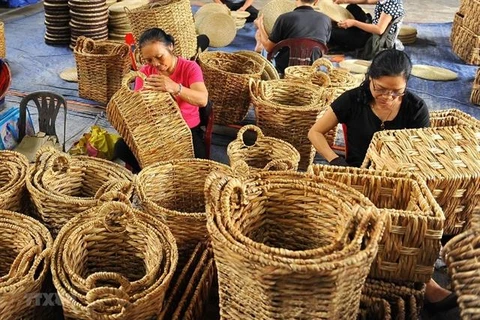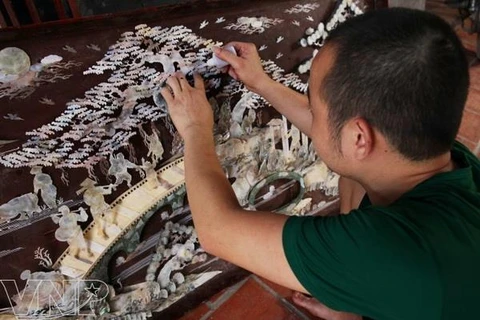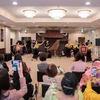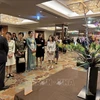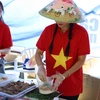Hanoi (VNA) – The administration of Hanoi recently designated two craft villages in Phu Xuyen district as tourist destinations, a move aimed to develop not only local crafts but also tourism.
The new tourist sites are the mother of pearl inlaid and lacquer product making village in Chuyen My commune and the tailoring village in Van Tu commune.
Chuyen My commune has long been famous for mother of pearl inlaying with all of its seven villages specialised in making mother of pearl inlaid products, lacquer items and mother of pearl materials.
Local craftsmen produced millions of items of all sizes each year, ranging from wooden beds, cupboards, tables and chairs to lacquer paintings. The craft has been generating considerable economic benefits for local residents.
Meanwhile, Van Tu commune is known as the only place in Vietnam to have suit making as a traditional craft. There are about 1,500 households in the commune at present, up to 70 – 80 percent of which are specialized in suit making.
In recent years, the development of tailoring has helped raised local households’ income to 500 million – 700 million VND (21,500 USD – 30,200 USD) each year, some even earn billions of VND from this craft.
The designation of the two villages as tourist sites is hoped to develop not only the local crafts but also create more tourist magnets for the capital city of Hanoi.
The municipal People’s Committee tasked the two communes’ authorities with managing and developing tourism in the villages in accordance with the Law on Cultural Heritage and relevant legal regulations.
The capital city boasts 1,350 craft villages, which account for almost one-third of the total number across Vietnam, with 305 of them recognised as traditional ones. It is also home to 47 of the 52 traditional crafts nationwide.
According to the municipal People’s Committee, the annual revenue of the 305 traditional villages is more than 20 trillion VND (861.5 million USD) on average. Local per capita income is around 4 million – 5 million VND per month.
Despite the big number of craft villages, only few of them have been listed as tourist destinations.
In Phu Xuyen district, the fact that many long-standing craft villages haven’t been officially recognised has somehow made it hard for them to become more popular among travelers. As a result, their potential has yet to be fully tapped.
In its craft and craft village development plan until 2020, Hanoi listed several projects prioritised for investment, including 17 on developing tourism in craft villages. However, only two of the 17 villages have successfully developed their traditional crafts in association with tourism, namely Bat Trang ceramics village and Van Phuc silk village. The work hasn’t been carried out in the 15 remaining villages.
Among local traditional craft villages, Hanoi authorities classified seven as villages that need preservation and cultural heritage value to be brought into play; 10 as villages for tourism and in need of long-term preservation and development; and 17 as villages in need of long-term preservation.
To develop tourism in craft villages, Hanoi will select those recognised as traditional craft villages thanks to their rich cultural identities, attractive surrounding, and favourable transport system to build them into sample models, then expanding to other villages.
The Hanoi craft village association has selected potential ones such as Thach Xa bamboo dragonfly-making village in Thach That district, Chuon Ngo village in Phu Xuyen district, Du Du wood sculpture village and Chuong conical hat making village in Thanh Oai district.
According to the municipal Department of Tourism, Hanoi welcomed about 23.8 million visitors in the first 10 months of 2019, up 9.7 percent year on year. They included more than 5.3 million foreigners and nearly 18.5 million Vietnamese travellers. The city raked in some 83.16 trillion VND (3.6 billion USD) in tourism revenue during the period, rising 31.3 percent from the same period last year.
It hopes to attract about 28.6 million tourists this year, including 6.7 million foreigners and 21.9 domestic visitors./.
The new tourist sites are the mother of pearl inlaid and lacquer product making village in Chuyen My commune and the tailoring village in Van Tu commune.
Chuyen My commune has long been famous for mother of pearl inlaying with all of its seven villages specialised in making mother of pearl inlaid products, lacquer items and mother of pearl materials.
Local craftsmen produced millions of items of all sizes each year, ranging from wooden beds, cupboards, tables and chairs to lacquer paintings. The craft has been generating considerable economic benefits for local residents.
Meanwhile, Van Tu commune is known as the only place in Vietnam to have suit making as a traditional craft. There are about 1,500 households in the commune at present, up to 70 – 80 percent of which are specialized in suit making.
In recent years, the development of tailoring has helped raised local households’ income to 500 million – 700 million VND (21,500 USD – 30,200 USD) each year, some even earn billions of VND from this craft.
The designation of the two villages as tourist sites is hoped to develop not only the local crafts but also create more tourist magnets for the capital city of Hanoi.
The municipal People’s Committee tasked the two communes’ authorities with managing and developing tourism in the villages in accordance with the Law on Cultural Heritage and relevant legal regulations.
The capital city boasts 1,350 craft villages, which account for almost one-third of the total number across Vietnam, with 305 of them recognised as traditional ones. It is also home to 47 of the 52 traditional crafts nationwide.
According to the municipal People’s Committee, the annual revenue of the 305 traditional villages is more than 20 trillion VND (861.5 million USD) on average. Local per capita income is around 4 million – 5 million VND per month.
Despite the big number of craft villages, only few of them have been listed as tourist destinations.
In Phu Xuyen district, the fact that many long-standing craft villages haven’t been officially recognised has somehow made it hard for them to become more popular among travelers. As a result, their potential has yet to be fully tapped.
In its craft and craft village development plan until 2020, Hanoi listed several projects prioritised for investment, including 17 on developing tourism in craft villages. However, only two of the 17 villages have successfully developed their traditional crafts in association with tourism, namely Bat Trang ceramics village and Van Phuc silk village. The work hasn’t been carried out in the 15 remaining villages.
Among local traditional craft villages, Hanoi authorities classified seven as villages that need preservation and cultural heritage value to be brought into play; 10 as villages for tourism and in need of long-term preservation and development; and 17 as villages in need of long-term preservation.
To develop tourism in craft villages, Hanoi will select those recognised as traditional craft villages thanks to their rich cultural identities, attractive surrounding, and favourable transport system to build them into sample models, then expanding to other villages.
The Hanoi craft village association has selected potential ones such as Thach Xa bamboo dragonfly-making village in Thach That district, Chuon Ngo village in Phu Xuyen district, Du Du wood sculpture village and Chuong conical hat making village in Thanh Oai district.
According to the municipal Department of Tourism, Hanoi welcomed about 23.8 million visitors in the first 10 months of 2019, up 9.7 percent year on year. They included more than 5.3 million foreigners and nearly 18.5 million Vietnamese travellers. The city raked in some 83.16 trillion VND (3.6 billion USD) in tourism revenue during the period, rising 31.3 percent from the same period last year.
It hopes to attract about 28.6 million tourists this year, including 6.7 million foreigners and 21.9 domestic visitors./.
VNA


